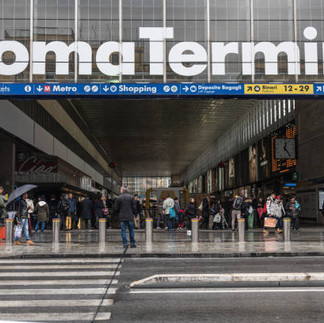Getting Around the City of Rome - Rome as a Port Stop
- Gail Gauvreau

- Sep 28, 2021
- 6 min read
Updated: Jun 19, 2023
Section Four of the Rome as a Pre or Post Cruise Stop
In this blog posting I address getting around the city of Rome.
My Rome as a pre or post cruise stop blog entries are divided into the following sections and as such, if you are looking for information on any of the subjects listed, go to that posting for the specific information that will best serve your needs:
1. History of Rome (2 blog entries)
2. Transportation to and from the airport
3. Transportation to and from the port
4. Getting around the city
5. Places to see (2 blog entries)
6. Rome Markets / Food Tours
7. Hop on Hop off buses
8. Civitavecchia as a port stop for Rome
9. Rome / Italy Fun Facts / Churches & Basilicas
Walking
On my first visit to Rome, I was in my early twenties and walking kilometers (or miles), was not an issue. Being long on enthusiasm and short on cash, anything I could do to save money was a must so walking became my “go to transportation option”.
I had booked a hotel near the Vatican and over the course of a week, I had walked to the Vatican, and most other points of interest. For example, from the Vatican to the Colosseum, it was about 4.4 kms (2.73 miles). From the Pantheon to the Colosseum it was approximately 1.8 km (1.1 miles). I could continue to give you distances but those are easy for you to figure out using any mapping app you have and inputting your location with where you want to go. If you are prepared to walk, you can see most or Rome’s important sites by walking. The upside is you will save money, the downside is that it is not possible to see everything in a short period of time and if you are on a one-day cruise stop, you will have to be selective about what you will be able to see. Maximize your options. If you are arriving by train, you will be able to walk south west to the Colosseum fairly easily. View the Colosseum, temple ruins, Forum, Palatino and then make your way to the Pantheon, Spanish Steps and Trevi fountain before looping north and east again back to the termini. There are several museums and numerous interesting churches along the way but depending on the speed at which you walk, and the time spent at each location, you may not have time for a whole lot more.
If you start touring west of the Tiber river, such as at Vatican City, you will find yourself able to traverse (with average walking capability), St Peter’s Basilica, St Peter’s Square, Vatican Museum and to the Castel Sant'Angelo (which is approximately 1.5 km from the entrance to the Vatican).
Bus
I have used the local bus services for limited trips around Rome. For example, there is a bus from the termini to the Vatican and I have used that a few times and also taken the local buses to get to the catacombs and other areas not serviced by the underground (subway). Please note, you must purchase your tickets before you get on the bus and these can be bought from tobacconists and vending machines which you will find located at Metro stations and major bus stops. A B.I.T standard ticket - valid for one metro ride or 100 minutes on all city buses will cost you €1.50.
I was told that you can buy bus tickets at bars but I have never found a bar that sold them.
My personal experience in taking the buses in Rome is that it was fairly easy if you are on a direct line, such as the termini to the Vatican. It can be a little difficult if you have to make several changes as it was not well marked and trying to marry up the bus transfers on remote routes was a wee bit confusing.
Underground (subway)
I found taking the subway in Rome to be fairly easy, efficient and fast. A word of warning: “Watch for Pickpockets” particularly around major stations.
As with the buses, you can buy your tickets from tobacconists, vending machines and ticket kiosks at metro stations. As in the case with all forms of transportation systems in Europe, there are passes available which can afford you savings over time if you are using public transport for more than a single day. Rome has such passes. You should note that the tobacco shops sell tickets only and do not sell the passes.
- 24-hour ticket - valid for unlimited metro, bus, and train travel within Rome for 24 hours from validation at a cost of €7,
- 48-hour ticket valid for unlimited metro, bus, and train travel within Rome for 48 hours from validation at a cost of €12.50.
- 72-hour ticket - valid for unlimited metro, bus, and train travel within Rome for 72 hours from validation at a cost of €18.
- C.I.S. - valid for 7 calendar days
You can look at bus and train transportation maps online:
https://www.atac.roma.it/en/utility/maps
Rent a Car
Car rentals come in all shapes, sizes and prices which are too many to annotate in this blog posting. Renting a car has the added benefit of having a private means of transportation at your disposal any time you want to go somewhere. The downside is driving in Rome traffic which is notoriously busy and trying to find parking on narrow, crowded streets. Unless you have a lot of experience driving in Rome, or are going outside the city to see various sights, I suggest you give this method of transportation a pass.
Private Car and Driver Hire
To hire a car and driver is a pricier option, but it will give you seating comfort, limit exposure to other people and provide you with a driver who takes you directly to where you want to go. Once again, prices vary too much to give a quote as the vehicles come in all sizes and prices which will depend on the number of passengers and the length of hire. Prices are competitive so it is possible to get some relatively good deals. Make sure you book with a reputable company and check references. You can also ask about the driver covid vaccination status.
Taxis
I have often taken taxis around Rome both for work or to take me to points of interest. Although Rome traffic can be bad and taxis will get caught up in traffic jams at rush hour, drivers do have knowledge of alternate routes to take at times of heavy traffic congestion. So although they may not be able to avoid the brutal traffic jams, they can and will take alternate routes when possible.
Just a quick word of warning, it is best to take a taxi from a taxi stand. If a taxi stand is not available, ensure you can see the taxi license and driver information on the back of the front seat of the vehicle. Make sure the meter is turned on when the taxi starts to move. If the driver tells you the meter is broken, take another taxi of negotiate a price in advance.
Hop on Hop Off buses (also known by the short form of HoHo buses)
If you want to move from tourist point to tourist point around the city, consider a day or two-day pass on a hop on/hop off bus. These buses will always go to various points of interest and operate throughout the day allowing you to hop off at any location, do a little sightseeing and then hop on another bus to move to another location. In Rome there are different tour operators, but the prices are generally the same. At the present time the cost is Adult: € 22, Child: € 14 with some operators offering senior discounts. You will see the Hop on Hop off bus stops around the city and there are two that I have used that are near the termini (north, west corner). You can buy tickets from the individual ticket sellers at the stops.
If you have any comments or questions relating to this blog post, as always, please feel free to leave a comment on this page or contact me at: gailgauvreau@gailgauvreau.com
Next up: Rome – Places to See – Part One


























Comments